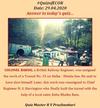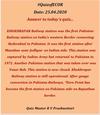Search Forum
Filters:
Page# 2 Blog Entries
Apr 29 2020 (18:24) 52451/Shivalik Deluxe Express | BOF/Barog (2 PFs)
SAPTARSHI^~
SAPTARSHI^~ 26506 blog posts◾An engineer, a gunshot, and a tunnel that he could not complete add up to a great piece of railway history◾
.
It is imperturbably quiet. The few locomotives in the yard are motionless. Gangmen go about their work. From the platform’s far edge, one can see the low hills of the Shivalik range, silhouetted against a cloudless sky. There is a hint of moving mist over their wooded tops.
....
more...
.
It is imperturbably quiet. The few locomotives in the yard are motionless. Gangmen go about their work. From the platform’s far edge, one can see the low hills of the Shivalik range, silhouetted against a cloudless sky. There is a hint of moving mist over their wooded tops.
....
more...
The breaks release and the wheels clang as Train No. 52453 gets in motion. The first, tentative movement is through sal and silk-cotton clusters. Blades of wild grass on both sides of the tracks are speckled with dew that catch the first shafts of light. We are mostly in a silent glide before the engine imparts more combustion to climb higher.
.
There is the sudden scent of chir pines in the early autumnal air. The bird calls, still audible, are intermittently muffled by the mournful, contrapuntal horn of the old engine. As the foothills turn steeper, the rickety, rackety train puffs and huffs up the sharper gradients over masonry bridges and through endless tunnels amidst dense pines. The grandness of the engineering conception is unmissable.
.
•Trundling through valleys•
.
It’s a two-hour, 40 km journey to the quaint Barog station in Solan district in Himachal Pradesh. The Kalka-Simla Railway is now a UNESCO World Heritage Site.
.
Trains operate over 880 bridges, over 919 turns and through 102 tunnels. That is the techno-engineering aspect. The slow trundle through the hills and valleys covered with pines, deodars, oaks, willows and blooming rhododendrons is the aesthete’s reward.
.
When a passing cloud lifts on the back of a strong wind, faraway mountains with snow peaks appear momentarily.
.
Barog comes after 32 tunnels. The over-hanging pine canopy parts ever so slightly to the sides to reveal the entrance to Tunnel No. 33. This is the longest straight tunnel in the railways and is 1.14 km long. It is the straightest tunnel in the world, which is associated with local tales and legends. Inside it, the engine’s amiable horn becomes a darkening roar before the train gently rolls into the station yard with two apologetic, staccato horns and pulls along the platform.
.
Barog station is what an Indian railway station is not. It is unreal, clean, uncrowded, totally jostle-free. The woodwork is brilliant blue with a forest backdrop.
.
Small tracks intertwine in smooth curvature before disappearing in straight lines beyond the signalman’s cabin in a single track.
.
Barog town derives its name from the railway station. It is a small hill station. At about 4,500 ft in the Himalayan foothills, it is mildly cold. In the British era, hill trains would stop here for an hour, and sahibs and memsahibs would have a leisurely and elaborate meal. The dining hall with the viewing gallery is still intact. The dusty plains of the Punjab would become peremptorily forgotten strands of memory and the ascent of the hills, with their coniferous crowns, truly began here.
.
Colonel Barog, a railway engineer, was assigned the work of Tunnel No. 33. The Barog tunnel is precisely 1,143.61 mt long. He made his calculations and as per the usual practice ordered the crew to drill from both sides of the mountain. He had planned that after a while both sets of drillers would meet at the centre and complete the tunnel.
.
The crew kept drilling but could not come to the meeting point. In fact, their trajectories seemed to have diverged. Morale dipped and everyone grew frustrated.
.
Col. Barog was a worried man. He soon realised that his calculations had gone awry. The tunnel would not be completed and the project was a failure.
.
The British government fixed responsibility on Col. Barog and he was fined ₹1 for causing a loss to the exchequer and wasting government resources.
.
Col. Barog felt humiliated by the censure and became depressed. His professional reputation had been dented.
.
•Dead end•
.
One day he went for a walk near the unfinished tunnel, accompanied only by his dog. Weighed down by despair, he decided to end his life. In that twilight moment, he removed his revolver from the holster and shot himself. Local people say that his terrified dog, who found the master lying in blood, ran to the village. But when people reached the tunnel mouth, Col. Barog was already dead.
.
The work of the tunnel was reassigned to Chief Engineer H.S. Harrington, who completed the tunnel in 1903. But it is said that he too could not properly align the two segments. He is said to have sought the advice of a spiritual person from Chail, a diviner who indicated the correct course to drill. His name was Baba Bhalku.
.
The Shimla Railway Museum records, in fact, mention Baba Bhalku’s contribution.
.
Despite his calculation error, the government and the railways honoured Col. Barog and named the tiny hill village after him.
.
And where the old village was, is the present Barog railway station. The hillsides covered with pines and deodars lend it a lyrical quality.
.
Tunnel No. 33, the longest straight tunnel in the railways, is known as the Barog tunnel. It requires constant maintenance like any installation. To aid the maintenance staff, there are 55 lights inside. But often even this is insufficient. So for more light, the staff uses a reflecting mirror to direct sunlight into the tunnel, an old practice that is still continued.
.
Since light travels straight and the Barog tunnel is straight, the beam reaches up to 800 metres. According to the Station Master, D.D. Upadhyaya, reflectors can be used at both ends if needed.
.
Villagers believe the good colonel still haunts the tunnel, and that one can hear an Englishman whispering inside its dark confines.
.
The train from Solan has arrived. It halts for eight minutes. Evening has a transformative effect on Barog. A crisp breeze blows through the trees. The light is decidedly softer. The sky changes colour. You need a cardigan to ward off the chill. I hop aboard as the train moves. Inside Tunnel No. 33, there are no human or other voices. Only a mechanical reverberation.
.
click here
#indianrailwayshistory
© SAPTARSHI_KQU
please wait...Translate to English
please wait...Translate to Hindi
This was today's question of #QuizofECOR
please wait...Translate to English
please wait...Translate to Hindi

Apr 25 2020 (19:01) ZL/Indo Pak Border Munabao
SAPTARSHI^~
SAPTARSHI^~ 26506 blog postsEntry# 4617391 Tags Past Edits
Apr 25 2020 (19:04)
"Link
"
Apr 25 2020 (19:03)
"
Apr 25 2020 (19:02)
Station Tag: Munabao/MBF added by Better than the best^/1844918
Apr 25 2020 (19:02)
Station Tag: Indo Pak Border Munabao/ZL added by Better than the best^/1844918
"
"
Apr 25 2020 (19:03)
"
Apr 25 2020 (19:02)
Station Tag: Munabao/MBF added by Better than the best^/1844918
Apr 25 2020 (19:02)
Station Tag: Indo Pak Border Munabao/ZL added by Better than the best^/1844918
Today's question of #QuizofECOR ( click here ), was
.
• Name the Pakistan Railway station on India's western border that was captured by Indian Army in 1971 with the help of 1033 Railway Engineer Group Territorial Army?
.
◾KHOKHRAPAR...
more...
.
• Name the Pakistan Railway station on India's western border that was captured by Indian Army in 1971 with the help of 1033 Railway Engineer Group Territorial Army?
.
◾KHOKHRAPAR...
more...
railway station was the first Pakistan Railway station on India's western border connecting Hyderabad in Pakistan. It was the first station after Munabao near Jodhpur on Indian side. The station was captured by Indian Army but returned to Pakistan in 1972. Another Pakistan station that was taken over was Vasar Bah. This station is now closed. Khokhrapar railway station is still operational. After gauge conversion in Pakistan Railways, *Zero Point has become the first station on Pakistan side on Rajasthan border. click here
.
Quiz Master - R V Prashnottari
.
• Some narrations (with link) regarding above item:
◾The narrative that follows describes a young Captain’s personal experience, as an Observation Post (OP) Officer, during the advance from Munabao (last Indian railway station) to Naya Chor. Read on……
.
"...During the Night 3/4 December 1971, we crossed the International Border (IB) and captured the reinforced Pakistan’s border out post – Ghazi Camp. Same night, Khokhrapar (Pakistan’s first railway station across the IB), was also captured. However, by then the last Pakistani train had departed in a hurry....The desert terrain was devoid of any road or well developed tracks and it was very difficult to move (25 Pounder) guns. I was ordered to move with the guns and assist in their cross country movement. During this struggle, we got the idea of moving them on the metre gauge railway track. The idea was very successful..." click here
.
◾"Before partition, the metre-gauge railway connecting Barmer to Gadra Road and Munabao used to run right up to Hyderabad. Partition had given Gadra Road and Munabao to India but Gadra City went to Pakistan, as also the railway beyond Munabao. The Pakistani authorities had removed a portion of the track near the border and ran their train services only up to Khokhropar, a village about six kilometres form Munabao. Southern Command planned to revive the rail-link between Munabao and Khokhropar .." click here
.
Quiz Master - R V Prashnottari
.
• Some narrations (with link) regarding above item:
◾The narrative that follows describes a young Captain’s personal experience, as an Observation Post (OP) Officer, during the advance from Munabao (last Indian railway station) to Naya Chor. Read on……
.
"...During the Night 3/4 December 1971, we crossed the International Border (IB) and captured the reinforced Pakistan’s border out post – Ghazi Camp. Same night, Khokhrapar (Pakistan’s first railway station across the IB), was also captured. However, by then the last Pakistani train had departed in a hurry....The desert terrain was devoid of any road or well developed tracks and it was very difficult to move (25 Pounder) guns. I was ordered to move with the guns and assist in their cross country movement. During this struggle, we got the idea of moving them on the metre gauge railway track. The idea was very successful..." click here
.
◾"Before partition, the metre-gauge railway connecting Barmer to Gadra Road and Munabao used to run right up to Hyderabad. Partition had given Gadra Road and Munabao to India but Gadra City went to Pakistan, as also the railway beyond Munabao. The Pakistani authorities had removed a portion of the track near the border and ran their train services only up to Khokhropar, a village about six kilometres form Munabao. Southern Command planned to revive the rail-link between Munabao and Khokhropar .." click here
please wait...Translate to English
please wait...Translate to Hindi
Page# 2 Blog Entries






